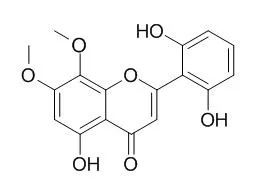| In vitro: |
| Molecules, 2015, 21(1):E15. | | Flavones Isolated from Scutellariae radix Suppress Propionibacterium Acnes-Induced Cytokine Production In Vitro and In Vivo.[Pubmed: 26712724 ] | Scutellariae radix, the root of Scutellaria baicalensis, has long been applied in traditional formulations and modern herbal medications. Propionibacterium acnes (P. acnes) in follicles can trigger inflammation and lead to the symptom of inflammatory acnes vulgaris.
METHODS AND RESULTS:
This study was aimed at evaluating the effect of Scutellariae radix extract and purified components isolated from it on inflammation induced by P. acnes in vitro and in vivo. The results showed the ethyl acetate (EA) soluble fraction from the partition of crude ethanolic extract from Scutellariae radix inhibited P. acnes-induced interleukin IL-8 and IL-1β production in human monocytic THP-1 cells. Seven flavones were isolated from the EA fraction by repeated chromatographies, and identified as 5,7-dihydroxy-6-methoxyflavone (FL1, oroxylin), 5,7-dihydroxy-8-methoxyflavone (FL2, wogonin), 5-hydroxy-7,8-dimethoxyflavone (FL3, 7-O-methylwogonin), 5,6'-dihydroxy-6,7,8,2'-tetramethoxy flavone (FL4, skullcapflavone II), 5,7,4'-trihydroxy-8-methoxyflavone (FL5), 5,2',6'-trihydroxy-7,8-dimethoxyflavone (FL6, Viscidulin II), and 5,7,2',5'-tetrahydroxy-8,6'-dimethoxyflavone (FL7, ganhuangenin). They all significantly suppressed P. acnes-induced IL-8 and IL-1β production in THP-1 cells, and FL2 exerted the strongest effect with half maximal inhibition (IC50) values of 8.7 and 4.9 μM, respectively. Concomitant intradermal injection of each of the seven flavones (20 μg) with P. acnes effectively attenuated P. acnes-induced ear swelling, and decreased the production of IL-6 and tumor necrosis factor-α in ear homogenates.
CONCLUSIONS:
Our results suggested that all the seven flavones can be potential therapeutic agents against P. acnes-induced skin inflammation. |
|






 Cell. 2018 Jan 11;172(1-2):249-261.e12. doi: 10.1016/j.cell.2017.12.019.IF=36.216(2019)
Cell. 2018 Jan 11;172(1-2):249-261.e12. doi: 10.1016/j.cell.2017.12.019.IF=36.216(2019) Cell Metab. 2020 Mar 3;31(3):534-548.e5. doi: 10.1016/j.cmet.2020.01.002.IF=22.415(2019)
Cell Metab. 2020 Mar 3;31(3):534-548.e5. doi: 10.1016/j.cmet.2020.01.002.IF=22.415(2019) Mol Cell. 2017 Nov 16;68(4):673-685.e6. doi: 10.1016/j.molcel.2017.10.022.IF=14.548(2019)
Mol Cell. 2017 Nov 16;68(4):673-685.e6. doi: 10.1016/j.molcel.2017.10.022.IF=14.548(2019)